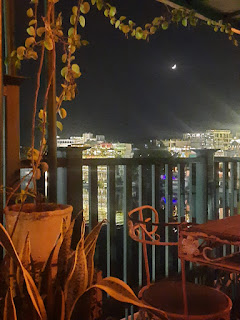Surkanda devi temple: The aura and the legend
After visiting the Eco Park in Dhanaulti, we headed towards Surkanda (सुरकंडा) devi temple. The temple is at an altitude of approximately 2700 meters. One can enjoy the panoramic view of the surrounding valleys and the Himalayan ranges from the top. From the motor road, one can either trek for around 2-3 kms to reach the temple or can avail the ropeway service from the station located just a few steps away. The ropeway ride costs ₹250 per head for a round trip.
The ropeway ride
As mentioned in my earlier post, you can skip the Bhatta Falls ropeway if you plan to visit Surkanda devi temple by ropeway, which is longer and provides an amazing bird's-eye view of the lush green valley.
 |
| View from the ropeway cable car |
It was quite sunny when we started, but as we started moving upward, the climate kept getting cloudier and colder. Riding back to the base in the cable cart offered a wider view of the surroundings, as seen in the video.
The temple
Surkanda devi temple is one of the Shakti Peethas, the sacred places of eternal power. Surkanda devi is the 'grama devata' of many villages around the region. The natives believe that mata Sati grants their wishes and pay regular visits to the temple.
The temple is structurally quite different from the ones I had seen earlier. After a bit of research, I found that the style is very similar to what they call the Sutlej valley style. This style is a combination of the following styles:
Pent roof style: A pent roof is a slanted roof made of rows of slates and it guards the underlying structure from heavy rainfall and snow.
Pagoda style: A pagoda is a tiered tower with multiple eaves. Pagoda-style temples are more evident in places where Buddhism was the long prevailing religion. Now, I really don't know if this region was under Buddhist influence ever or was there some other reason for exercising the pagoda style? That's the topic of further research.

The tall and slanting roof of the temple resembles pine trees found all over the region. Both of them are designed for being in tune with their surroundings. Isn't it an example of perfect kinship?
Just the roof of the temple gave me an opportunity to learn so much. As rightly said by American motivational writer William Arthur Ward, "Curiosity is the wick in the candle of learning".
As the legend goes, Goddess Durga was born as Sati to king Prajapati Daksha. She got married to Lord Shiva against her father's wish. Soon after the marriage, the king performed a yadnya to which he didn't invite the couple. When furious Sati questioned her father about the same, he made derogatory remarks about Lord Shiva. Deeply hurt by the insult, Sati threw herself into the fire and sacrificed her life. Out of the rage and sorrow, Lord Shiva started dancing fiercely (Tandava nritya), carrying Sati's body on his shoulders, and moving all around, causing immense destruction. Anticipating that Lord Shiva would be pacified once Sati's body disappeared from the scene, Lord Vishnu used his Sudarshan Chakra to divide Sati's body into multiple pieces. These pieces fell over the Indian continent and came to be known as Shakti Peethas, the holy shrines dedicated to Ma Shakti. As per the legend, Sati's head fell at the place where the temple is located.
My musings
I'm not a very religious person. But over the period of years, I have learnt to appreciate many notable aspects of our culture. I'll be discussing a couple of them here:
Daily prayers: There's this meditation for manifestation, which is said to help one bring their dream into reality. It's backed by some renowned doctors, and people in the West pay a hefty amount for learning the same. Here are the key steps of the meditation: sit down, close the eyes, calm down, now focus, open your heart, and manifest.
Aren't we taught to do the same through the daily prayers that we offer to god? How thoughtful it is to provide the masses with a powerful tool like this, in the name of god, so that they practice and exercise it regularly?
Indian mythology: Indian mythology is full of fascinating stories loaded with entertainment and learning. Instead of blatantly disregarding them as baseless and old-style, how about reconditioning them in a way that appeals to the modern generation, without changing their essence? This will surely help us connect with our roots.
In my next post I will be talking about the heavenly place we visited next. Happy trails to you, until we meet again!
(Videos and pictures by me and Abhijeet)





.jpeg)
Nice to hear about our culture.happy to know that our culture is being preserved .our culture is like a mosaic .combination is old &new .very rare &only culture in the world .
ReplyDelete